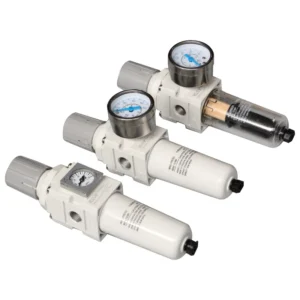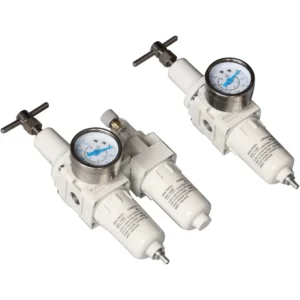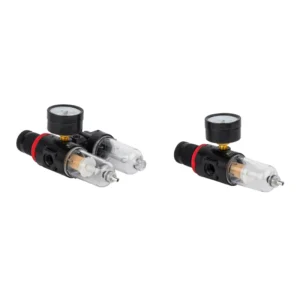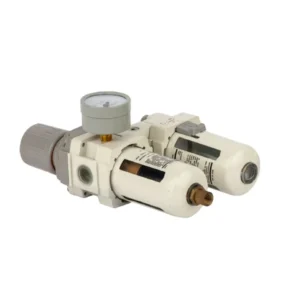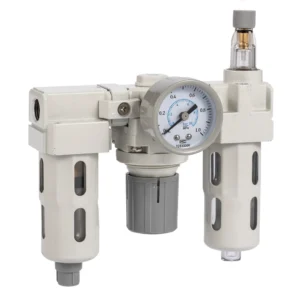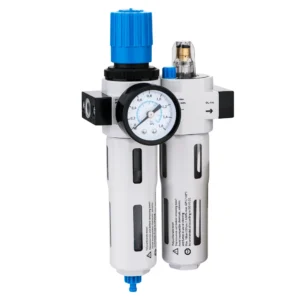Air Filter Regulator
Showing all 6 results
-
Air Filter Regulator
2000 SERIES
-
Air Filter Regulator
2000-02A SERIES
-
Air Filter Regulator
2000F SERIES
-
Air Filter Regulator
3000 SERIES
-
Air Filter Regulator
AIR REGULATOR
-
Air Filter Regulator
MINI SERIES
What is an Air Filter Regulator?
A Complete Guide to Air Preparation in Pneumatic Systems
An air filter regulator is a pneumatic component designed to clean, regulate, and maintain the quality of compressed air before it enters critical devices like valves, actuators, and control instruments. These units are essential in industrial automation, ensuring that compressed air systems operate reliably, safely, and with long service life.
An air filter regulator is a critical component in any compressed air or instrument air system. By ensuring clean, dry, and regulated air, it enhances performance, extends equipment life, and prevents system failures.
For optimal results, choose the right size, filtration level, and drain type based on your application. Whether for a control valve actuator, a pneumatic cylinder, or a sensitive measuring instrument, a well-selected filter regulator can make a big difference.
Air filter regulators perform three essential functions:
1. Filtering: Removes dust, oil, water, and other contaminants from compressed air.
2. Regulating: Controls and stabilizes air pressure to a desired setpoint.
3. Draining: Some models feature automatic drains to remove accumulated water.
________________________________________
🧩 Components of an Air Filter Regulator
• Filter Element: Usually made of sintered bronze or polyethylene, filters particles down to 5 or 40 microns.
• Regulator Valve: Maintains output pressure regardless of changes in input pressure.
• Bowl: Transparent or metal container that collects water and contaminants.
• Drain Valve: Manual or automatic drain for removing water buildup.
• Pressure Gauge Port: For attaching a pressure gauge to monitor regulated pressure.
________________________________________
⚙️ Types of Air Filter Regulators
1. Standard Air Filter Regulators
• Designed for general pneumatic systems.
• Simple to install and maintain.
2. Miniature / Compact Regulators
• Used in small equipment or limited-space areas.
• Lower flow rates but effective for light-duty tasks.
3. High-Flow Air Filter Regulators
• Ideal for systems requiring large air volumes.
• Common in manufacturing lines or pneumatic conveyors.
4. Precision Regulators (Instrument Air Regulators)
• Provide very stable and accurate pressure control.
• Used in instrumentation and control panels.
5. FRL Units (Filter + Regulator + Lubricator)
• Combines air filter, pressure regulator, and lubricator in one assembly.
• Reduces piping complexity and maintenance.
________________________________________
✅ Why Are Air Filter Regulators Important?
Compressed air systems carry contaminants like:
• Water vapor (condenses into liquid)
• Oil mist from compressors
• Dust, rust, and debris from piping
These contaminants can damage valves, actuators, and sensors. Air filter regulators protect equipment, enhance performance, and extend component life.
________________________________________
🏭 Common Applications of Air Filter Regulators
Air filter regulators are found in nearly every compressed air system:
• ✅ Pneumatic control valves and actuators
• ✅ Automation lines
• ✅ Food and pharmaceutical industries (requiring clean/dry air)
• ✅ Painting & spraying systems
• ✅ Measurement instruments
• ✅ Packaging machines
• ✅ Laboratories and test rigs
________________________________________
📊 Key Selection Parameters
Parameter Description
Port Size Usually 1/8″, 1/4″, 3/8″, 1/2″, or 1″
Filtration Level Typically 5 µm or 40 µm
Pressure Range Often 0.5 to 10 bar (adjustable)
Flow Rate Expressed in SCFM or NL/min, depends on port and model
Material Aluminum, brass, or polymer bowls
Drain Type Manual or automatic
________________________________________
💡 Special Features Available
• Auto Drain Bowls – For hands-free draining of moisture
• Metal Bowls – For high-pressure or rugged environments
• Built-in Pressure Gauges – For easy monitoring
• Modular Mounting – Can be attached to lubricators or additional filters
• Explosion-proof Versions – For hazardous environments
________________________________________
🔧 Installation Tips
• Always install the unit vertically with the bowl facing downward.
• Install as close as possible to the equipment it serves.
• Check the flow direction arrow on the body.
• Use thread sealant tape or compound to prevent air leaks.
• Drain bowls regularly or use automatic drains for unattended operation.
________________________________________
✅ Benefits of Using Air Filter Regulators
• Protects sensitive pneumatic equipment
• Ensures consistent operation
• Reduces downtime and maintenance costs
• Helps meet ISO 8573 air quality standards
• Improves overall energy efficiency in compressed air systems
________________________________________

